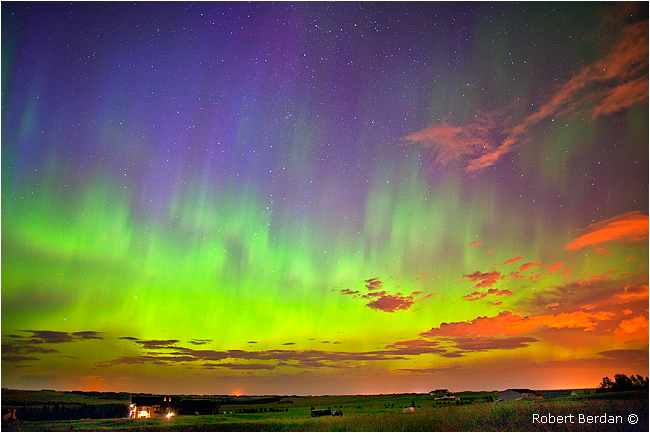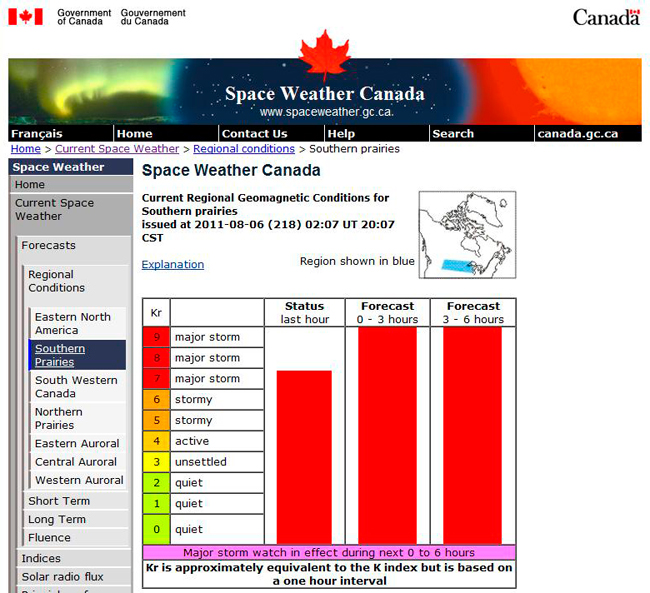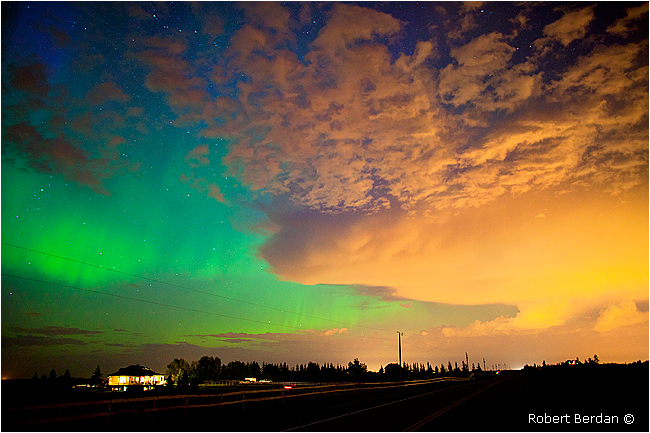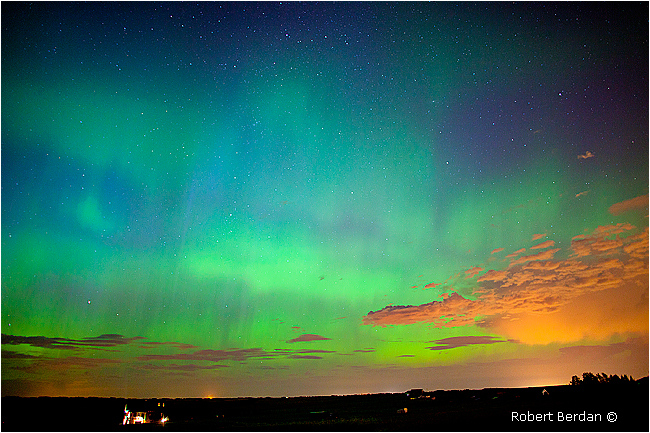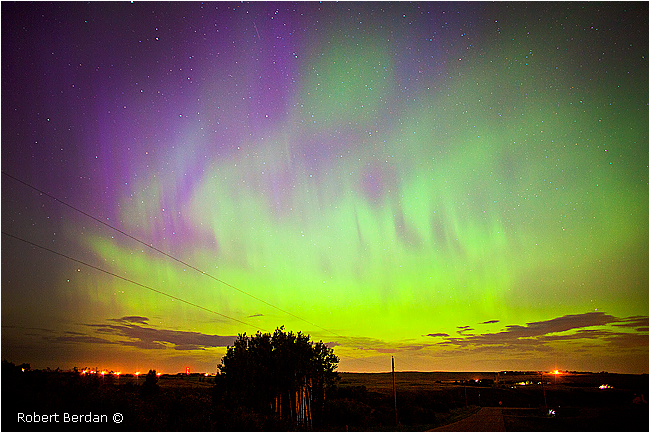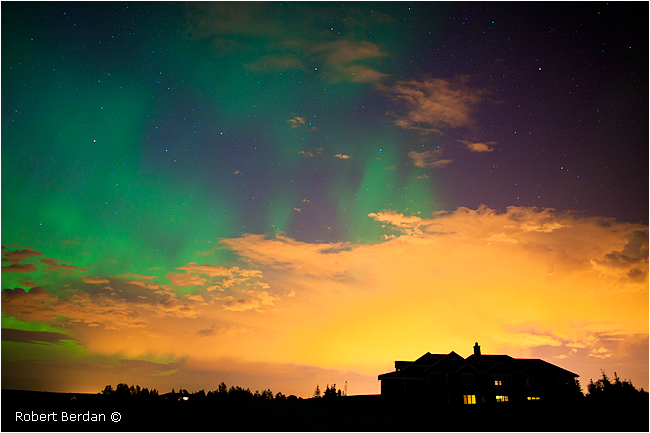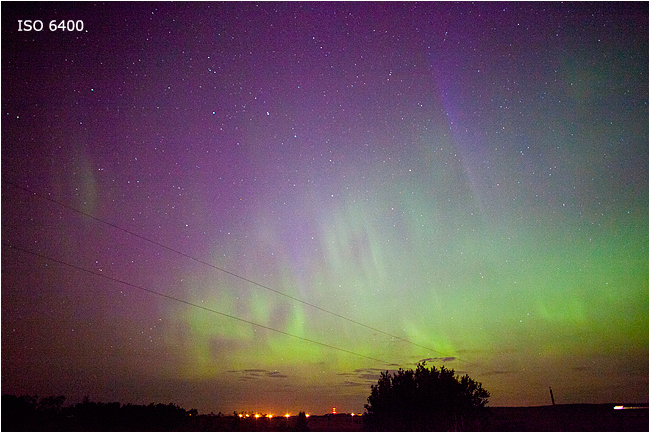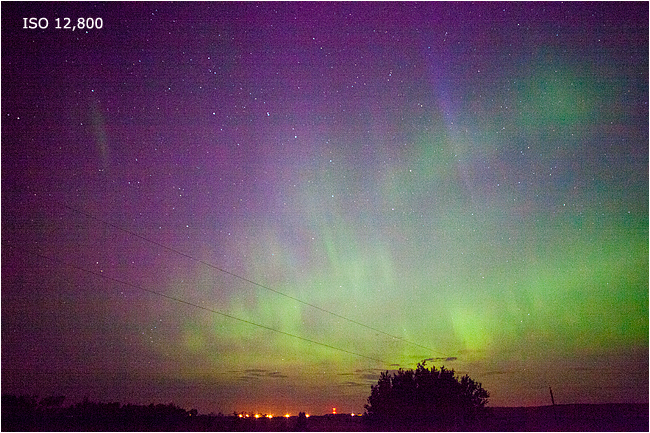
Photographing the Aurora (Northern Lights) Near Calgaryby Dr. Robert Berdan
Aurora and orange clouds. The light at the the top right is from the city of Airdrie: 24 mm F1.4, 5 seconds at ISO 800
Magnetic Field on August 5 and the next day on August 6, source Aurora Watch Web site. On the left the graph shows magnetic field activity during the Aurora storm on August 5th and on the right on August 6th with low activity. At 7:10 pm, August 5 I received an email, an Aurora alert notifying me that there was a high probability of an Auroral storm that evening. Anyone can subscribe to an Aurora Alert and be notified by email (free) or by phone (monthly charge) when there is a good chance of an Aurora. Aurora forecasting is essential because the protons and electrons released from the sun in a coronal discharge (explosion on the sun) can knock out power generators potentially costing millions of dollars to fix and can also be dangerous to astronauts in outer space. I also checked the Canada's space weather web site which provides aurora forecasts in different regions of the country and selected the Southern Prairies region where Calgary is located (see below).
Aurora forecast on August 5, 2011 for Southern Prairie region source: http://www.spaceweather.gc.ca/index-eng.php I had never seen the forecast rating over 6 in Calgary, at least not in the past year. Having a strong probability of an auroral storm is good, but the sky also has to be clear in order to see it. On August 5th in the evening we experienced several thunderstorms with hail, but the sky appeared to be clearing to the north west of the city. In the distance I could see more localized thunder storms heading my way and thought I might be able to photograph lightening and if it clears maybe the Aurora. At 10:30 pm I headed out and drove out Highway 1A (Bow Valley Trail) toward Cochrane. To the West was a heavy thunderstorm with lightening moving quickly to the south. Before reaching Cochrane I turned right at the top of the hill on Township road 262 (entrance to Retreat) and drove a short way down the road. I pulled over at a mail box and could see the Aurora in the north sky. I set up my Canon 5D Mark II camera with 24 mm F1.4 lens wide open and set the ISO at 1600.
One of the first photos I took, the cloud on the right is part of a storm that passed over and is heading toward Calgary. The
Looking straight North - I began to see the lights dancing and some purple colours streaming straight up. I experimented with different ISO speeds, set my Camera to A or Aperture priority mode and photographed using automatic exposure. At ISO 1600 my exposures ranged from about 2 to 8 seconds. At ISO 400 my exposures were about 15-30 seconds. Longer exposures result in less defined rays due to the blurring effect of the moving curtain of lights. However, I wanted to shoot some longer exposures as well in order to try and capture lightening flashes in the distance. The longer the exposure the greater you chance of capturing lightening. The thought of possibly capturing lightening and the Aurora had me excited, but it was not to be on this night.
Purple Rays with the big Dipper at the top of the photo - 24 mm F1.4 exposure 2.5 seconds ISO 1600
Looking directly North - 24 mm F1.4 exposure 5 seconds ISO 800 One of the things that I think makes for a good Aurora photograph is something interesting in the foreground, a house or fence for instance. If you point the camera just at the sky the viewer doe not have a reference for what part of the sky you are looking at.
24 mm F1.4 Exposure 5 seconds ISO 800
In the distance I could see lightening flashes. 24 mm F1.4, exposure 6 seconds, ISO 800
Purple Spikes visible to the naked eye shot up vertically into the sky. 24 mm F1.4, 6 seconds, ISO 800
I parked in this homes driveway to avoid blocking cars on the road - looking east toward Calgary it is easy to see the light pollution produced by the city. 24 mm F1.4, 4 seconds, ISO 800
On the Way home I decided to drive a short way up Lochend Road and pulled over the side. I could see the Fog rolling in. What is the Best ISO to use? It really depends on what you are looking for. Increasing the ISO speed shortens the exposure revealing finer detail and more small spikes but also increases the background noise. With the Canon 5D Mark II, I find that ISO speeds between 400-1600 are pretty good with minimal grain. As I dial up higher ISO speeds I begin to see more digital noise, though it may be hard to see in these low res web images below. It is also possible to reduce noise further using photoshop and the camera noise reduction settings, but all my pictures are taken at the default settings and they provide satisfactory results when I use ISO 1600 or lower. If you are using a slower lens e.g. F2.8 or F4, you may have to crank the ISO speed up higher to get reasonable exposure times under 60 seconds. The longer the exposure time, the more star trailing you will begin to see due to the rotation of the earth the stars will form curved trails on your photos. As I drove back into the city where I live in Calgary's north west the Aurora disappeared from sight due to the light pollution. On one rare occassion I have been able to see and photograph the Aurora from my backyard, but in general the Aurora is to faint within the city to see. Below are show several images taken at higher speeds and the resulting increase in noise.
Above - 2 second exposure
Above 0.5 second exposure - All with Canon 5D Mark II 24 mm F1.4 lens The exposure time also influences whether or not you will see star trailing due to the rotation of the earth. A simple formula is 600/focal length of the lens you are using to determine the longest exposure before you see the star trails. For 24 mm lens exposures of 25 seconds or less will have minimal star trails. Longer exposure and you will see the stars form arcs as they appear to rotate around the North star. It is likely that new cameras will offer even higher ISO speeds and lower noise in the future. Shooting the Aurora with a digital camera is much easier then with film and lets you see your results instantly. The instant preview is also valuable because a 10 second exposure is much more sensitive than human eyes and you will record colours that most of us can not see. If the Aurora appears faint take some pictures anyway and you will be amazed at how much more your camera captures. For those of wanting more technical information about photographing the Aurora with a digital camera please see my previous article. RB
The Stars indicate the sites where I photographed the pictures above - the roads are paved and there is a good view of the sky and minimal light interference. I can reach these sites within a 15 minute drive. Further out of the city the skies will be darker. Links & References:
Calgary Herald August 9 Published several of the Photos and a short Article http://www.calgaryherald.com/news/Spectacular+aurora+activity+near+Calgary/5221706/story.html National Geographic News published several pictures of the Aurora storm of mine on their web site August 10, 2011
|
